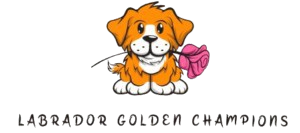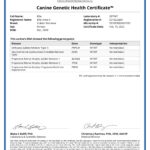Ellie Anne II
you can click on the legal License below to have a view in the Ofa organisation website
| None | DM (Degenerative Myelopathy) |
| Clear | GR-PRA1 (Progressive Retinal Atrophy in Golden Retrievers) |
| Clear | GR-PRA2 (Progressive Retinal Atrophy in Golden Retrievers) |
| None | GRMD (Golden Retriever Muscular Dystrophy) |
| Clear | ICT (Ichthyosis) |
| Clear | NCL5 (Neuronal Ceroid Lipofuscinosis) |
| Clear | prcd-PRA |
SARA
you can click on the legal License below to have a view in the Ofa organisation website
PennHIP Certified
| Clear | DM (Degenerative Myelopathy) |
| Clear | GR-PRA1 (Progressive Retinal Atrophy in Golden Retrievers) |
| Clear | GR-PRA2 (Progressive Retinal Atrophy in Golden Retrievers) |
| Clear | GRMD (Golden Retriever Muscular Dystrophy) |
| Clear | ICT (Ichthyosis) |
| Clear | NCL5 (Neuronal Ceroid Lipofuscinosis) |
| Clear | prcd-PRA |
Windsong Willow
you can click on the legal License below to have a view in the Ofa organisation website
| None | DM (Degenerative Myelopathy) |
| Clear | GR-PRA1 (Progressive Retinal Atrophy in Golden Retrievers) |
| Clear | GR-PRA2 (Progressive Retinal Atrophy in Golden Retrievers) |
| None | GRMD (Golden Retriever Muscular Dystrophy) |
| Clear | ICT (Ichthyosis) |
| Clear | NCL5 (Neuronal Ceroid Lipofuscinosis) |
| Clear | prcd-PRA |
Are males or females better?
Fortunately, whether you pick a male or female, golden retrievers are equally loving, active, playful, loyal, and smart.The only real differences are in appearance and maturity:Males tend to be taller and heavier than females. Males also have broader heads, thicker “manes,” and longer coats while females have more narrow heads and noses.
How big do Golden Retrievers get?
- Males average 23 – 24 inches tall and weigh between 65 – 75 pounds.
- Females average 21.5 – 22.5 inches tall and weigh between 55 – 65 pounds.





